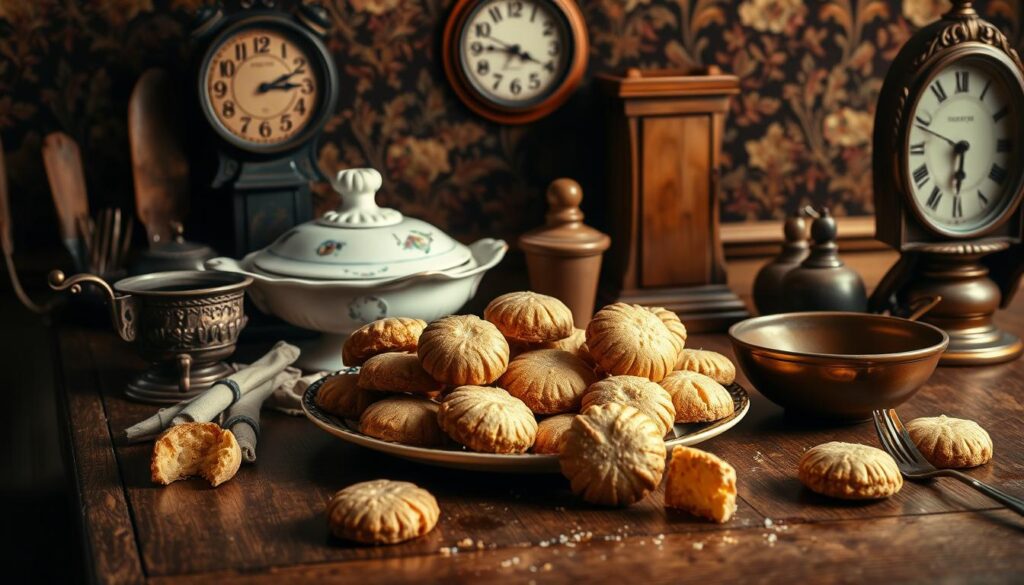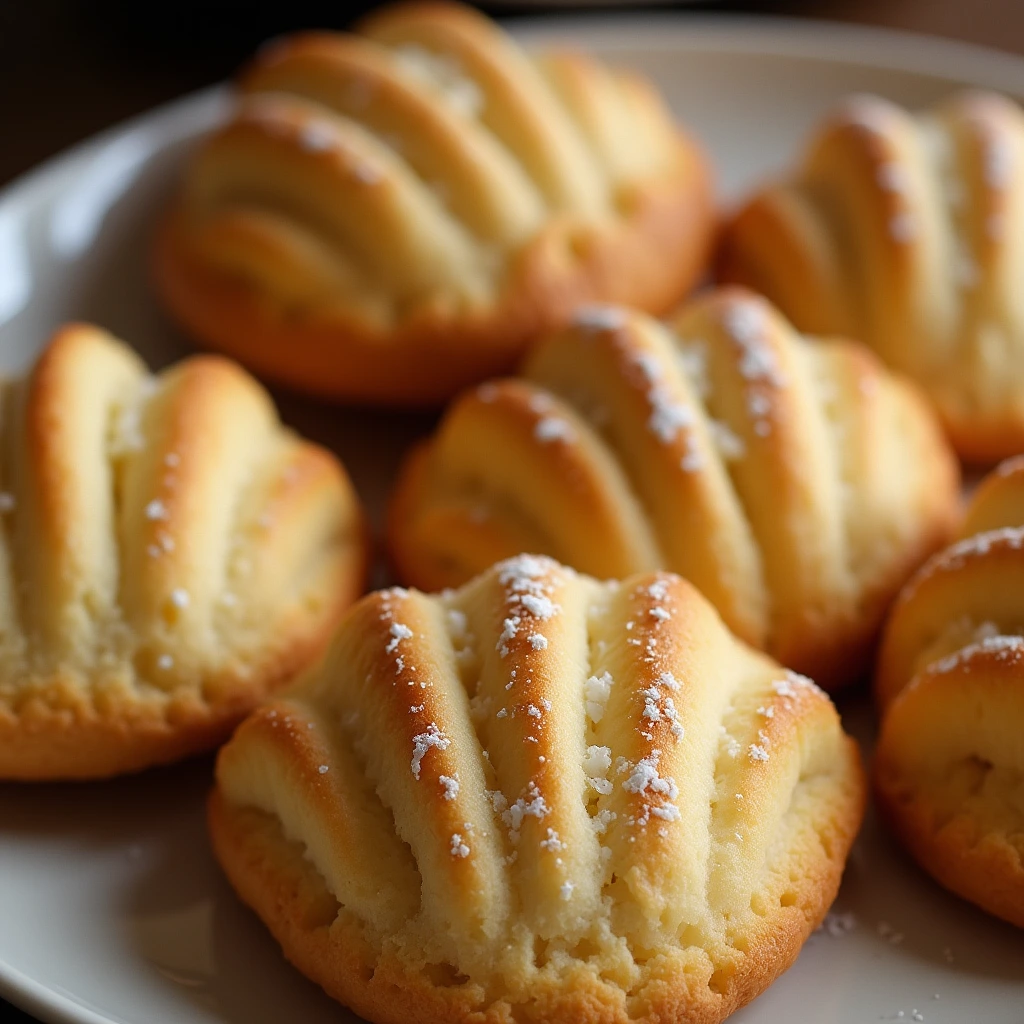Madeleine cookies are a key part of French pastry, loved for their unique shape and taste. They bring joy to dessert fans, perfect for lazy mornings and cozy afternoons. Julia Child once said, “A celebration often requires a sweet treat like these iconic cookies.” This shows why madeleines are a favorite among French desserts.
They started in Lorraine in the 1700s and became famous at Versailles. French writer Marcel Proust called them “madeleine memory,” showing how they bring back childhood memories. Today, Commercy makes over 200 million madeleine cookies every year, loved worldwide.

Key Takeaways
- Madeleine cookies are one of France’s most beloved desserts.
- These pastries are commonly enjoyed for breakfast and during the afternoon goûter.
- They originated in the 1700s in Commercy, Lorraine, and were popularized at Versailles.
- Marcel Proust’s “madeleine memory” concept highlights their nostalgic impact.
- Over 200 million madeleine cookies are produced each year in Commercy, France.
- Modern variations incorporate flavors like lemon zest, honey, and vanilla.
- Madeleine pans are easily available in stores and online for home bakers.
The Allure of Madeleines
Madeleines have won the hearts of many, becoming a key French pastry. They have a delicate shape and a rich, buttery texture. This makes them a joy to eat, whether at tea time or as a snack.
Making these treats is quick, taking just about 10 minutes. They can be made in many flavors, like matcha or cocoa. Baked at 190°C (375°F) for 10-12 minutes, they taste best right after baking.
A madeleine tray costs around ten pounds on Amazon. This small investment brings great joy. Places like St. John restaurant cook them fresh, showing their French heritage.
Madeleines also bring back fond memories of French culture. They remind us of Parisian tea times. With their unique flavors and careful preparation, they are more than a sweet treat. They are a piece of French tradition.

History of Madeleines: A Cultural Staple
The history of madeleines is deeply rooted in French culture, dating back to the 17th century. These small sponge cakes, known for their shell-like shape, come from the Lorraine region. They were first made in Commercy and Liverdun.
The term “madeleine” for these cakes appeared in the mid-18th century. By the 1760s, Commercy was making them on a large scale. By the late 19th century, they were a favorite among the French upper class.
Traditional madeleines use finely ground almonds and sometimes lemon zest for a zesty taste. Their cultural importance grew through literature, like Marcel Proust’s “In Search of Lost Time.” He used them to describe memories.

Madeleines have become a staple in many cuisines, showing their enduring appeal. Making them involves careful steps, from chilling the batter to baking them just right. This process turns them into more than just a dessert; they are a symbol of French culinary art and cherished memories.
| Year | Event | Significance |
|---|---|---|
| 17th Century | Origins of Madeleines | Introduced as a regional delicacy in Lorraine. |
| Mid-18th Century | Term “Madeleine” Emerges | First use of the name to describe the small cake. |
| 1760s | Mass Production Begins | Madeleines become widely popular and accessible. |
| Late 19th Century | Staple of French Bourgeoisie | Recognized as an essential part of the diet. |
What Makes Madeleines Unique?
Madeleines are a beloved French treat known for their soft sponge cake texture. They are baked in special pans that give them a unique shell shape. This shape, with its bumpy surface and gentle hump, makes them stand out.
These cookies are traditionally flavored with vanilla and lemon. But they can also be made with many other flavors. This makes them a favorite among those who love pastry.
Madeleines have a long history, dating back to the 1700s in Commercy, Lorraine. They became famous again thanks to Marcel Proust’s writings. Enjoyed with tea or coffee, they are a big part of French culinary traditions.
| Characteristic | Description |
|---|---|
| Texture | Soft and sponge-like, easy to enjoy. |
| Shape | Resembles a seashell with a bumpy surface and a hump. |
| Flavor | Classic flavors include vanilla and lemon; versatile for various infusions. |
| Origin | Attributed to Commercy, France, with roots in the 1700s. |
| Cultural Significance | Gained modern popularity through references by Marcel Proust. |
| Baking Techniques | Incorporates warm ingredients, chilled dough, and precise baking temperatures. |
Why Are Madeleine Cookies So Good?
Madeleine cookies have been loved since the 18th century. They are special because of their perfect mix of ingredients and the memories they bring. Each bite is a mix of taste and nostalgia.
The Perfect Blend of Ingredients
Madeleine cookies are made with simple yet top-notch ingredients. They include flour, sugar, eggs, almonds, and lemon zest. The use of unsalted butter, like brown butter, adds a rich flavor.
This mix creates a deep taste with a hint of nuttiness. It makes the taste of madeleines truly unique.
Texture and Flavor Profile
The texture of madeleine cookies is key. They have a soft inside and a crispy outside. This makes every bite enjoyable.
These cookies come in many flavors, from vanilla to raspberry and green tea. This means there’s a flavor for everyone.
Emotional Connections and Memories
Madeleines are more than a snack; they bring back memories. They remind people of happy times with family and friends over tea or coffee. This is shown in books, where simple things bring back strong feelings.
Enjoying madeleines is more than just tasting them. It’s about the joy and comfort they bring.
| Ingredient | Importance |
|---|---|
| Flour | Provides structure |
| Sugar | Adds sweetness and moisture |
| Eggs | Contributes to richness and texture |
| Almonds | Enhances flavor and texture |
| Lemon Zest | Adds a fresh brightness |
| Brown Butter | Deepens flavor with nuttiness |
The Cooking Technique Behind Perfect Madeleines
Making perfect madeleines requires careful techniques to improve their taste and texture. It’s important to focus on details, like using brown butter and chilling the batter. These steps make a big difference.
Importance of Brown Butter
Brown butter makes madeleines special by adding richness and depth. It’s made by heating butter until it’s golden brown, revealing nutty flavors. It’s crucial to watch the butter closely to avoid burning, ensuring it enhances the taste.
Chilling the Batter
Chilling the batter is a key step that’s often missed. Refrigerating it for at least 4 hours or up to 2 days helps the ingredients mix well. This cold time makes the madeleines light and airy, with a perfect dome shape.
| Ingredient | Amount |
|---|---|
| All-Purpose Flour | 2.6 ounces |
| Granulated Sugar | 2.6 ounces |
| Baking Powder | 1/2 teaspoon |
| Kosher Salt | 1/4 teaspoon |
| Large Eggs | 2 |
| Vanilla Extract (optional) | 1.5 teaspoons |
| Unsalted Butter | 2.6 ounces |
By learning these techniques, bakers can make madeleines that look great and taste amazing. These French cookies are truly delightful.
Madeleine Cookies Recipe Using Cream
Try baking madeleines with this madeleine cookies recipe using cream. These French pastries are a mix of cookies and cakes. They’re perfect with tea or coffee. You’ll need just six ingredients: butter, eggs, sugar, flour, baking powder, and cream.
Start by whisking eggs and sugar until they’re pale and thick. Then, fold in flour gently to keep it airy. The classic madeleine recipe needs chilling for at least an hour. This step helps get that special hump on the cookies.
This recipe is quick, taking under 30 minutes. It’s a fast and rewarding baking experience.
- Use a nonstick madeleine pan for easy removal.
- Try garnishing with powdered sugar or dipping in chocolate.
- Use gluten-free flour or dairy-free butter for allergen-friendly options.
- Keep madeleines for 5 to 7 days at room temperature or freeze them.
This madeleine cookies recipe using cream ensures each batch is special. Brown sugar adds a rich flavor. It’s easy for all bakers to make, whether in traditional shapes or creative ones.
Pairing Madeleines with Drinks
Pairing madeleines with drinks is a delightful tradition that enhances the enjoyment of this French pastry. The contrasts in flavor and texture between madeleines and beverages create memorable experiences. This is true, even during moments of indulgence like le goûter, the popular afternoon tea ritual in France. Exploring suitable drink pairings can elevate the simple pleasure of madeleines into extraordinary culinary experiences.
Madeleines and Tea Traditions in France
Madeleines and tea share a special relationship in French culture. The buttery, delicate texture of madeleines perfectly complements various types of tea. This includes robust black tea or herbal blends. Serving madeleines alongside traditional teas not only allows for a delightful flavor fusion but also honors the customs associated with afternoon tea.
Enjoying these French pastries during this cherished ritual offers a perfect synergy. It brings together the flavors of madeleines and tea in a beautiful way.
Perfect Companions: Coffee or Hot Chocolate?
For those who prefer to indulge in coffee and madeleines, this pairing creates a rich and satisfying experience. The bold flavors of freshly brewed coffee or espresso balance the sweetness of the madeleines beautifully. On the other hand, for a younger palate or a comforting dessert, hot chocolate served with madeleines provides a warm, indulgent experience.
This captures the essence of coziness. These options expand the enjoyment of madeleines, allowing individuals to choose their preferred beverage. This way, everyone can appreciate the versatility of this beloved treat.
Popular Variations and Flavors
The world of madeleine flavors is rich and varied. Classic recipes often include lemon zest, vanilla, or almond. These flavors enhance the madeleine’s delicate taste, adding a gentle sweetness.
*Creative madeleine recipes* offer new flavors. Matcha adds a vibrant green color and a hint of earthiness. Chocolate-infused options are perfect for those with a sweet tooth. Seasonal spices like cinnamon and nutmeg make the madeleines cozy in cold weather.
The classic French madeleine recipe has a high rating of 4.96 out of 5 from 65 votes. It makes 20 madeleines in just 20 minutes, with a 12-minute cooking time. The recipe uses unsalted butter and large eggs, which can be modified for different flavors.
- Lemon madeleines with fresh zest
- Chocolate-dipped madeleines for an indulgent treat
- Matcha green tea for a unique twist
- Spiced seasonal varieties featuring cinnamon and nutmeg
These changes let bakers try new things while keeping the original recipe in mind. Exploring these flavors shows that madeleines can be endless, inviting all bakers to try new recipes.
Conclusion
Madeleines have a rich history that started in France in the 18th century. Their classic recipe has been passed down through generations. The “hump” they form while baking adds to their charm and shows the care in making each one.
The modern recipe combines flour, sugar, and butter. It’s wrapped in the warmth of nostalgia. This mix creates a pastry that’s both classic and comforting.
People love madeleines for their unique flavors and textures. Bakers enjoy trying new tastes, like brown butter or espresso. Beginners find joy in the simple process of mixing ingredients for a delicious treat.
Madeleine cookies are more than just a dessert. They bring people together, sharing moments and celebrating creativity in the kitchen. Their delicate taste and texture remind us of the joy of sharing food, making them a favorite for many.
FAQ
What makes madeleine cookies a popular choice among desserts?
Madeleines are loved for their unique texture and shape. They have a simple yet rich flavor. This makes them perfect for any occasion, from tea time to casual snacks.
How did madeleines get their name?
The name “madeleine” comes from a young girl named Madeleine. She inspired the creation of these cookies in Commercy. King Louis XV’s royal endorsement made them a staple in French pastry.
Why is browning the butter important in madeleine recipes?
Browning the butter makes madeleines taste richer and nuttier. This step is key to their delicious flavor.
Can I customize madeleine cookies with different flavors?
Yes, you can! Madeleines can be flavored with citrus, vanilla, chocolate, or matcha. This lets bakers get creative and find their favorite flavors.
What is the ideal way to serve madeleine cookies?
Madeleines are best with tea during le goûter, an afternoon tea in France. They also go well with coffee or hot chocolate, making them even more indulgent.
Is there a specific technique to achieve the signature dome shape of madeleines?
Yes, chilling the batter is key for the dome shape. It affects the texture and helps them rise properly while baking.
Are there any special ingredients that enhance a madeleine cookies recipe?
Adding cream makes madeleines moister and richer. This creates a delightful texture and flavor that dessert lovers enjoy.
How long can madeleines be stored, and what’s the best way to preserve them?
Madeleines are best eaten fresh. But they can be stored in an airtight container at room temperature for up to three days. Freezing is also an option to keep their texture.

